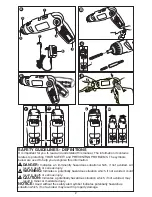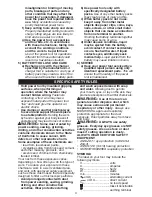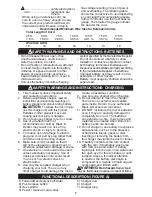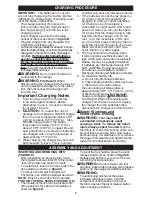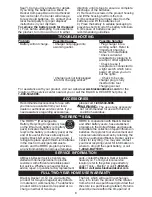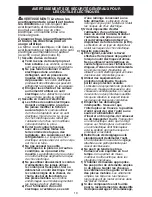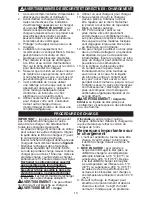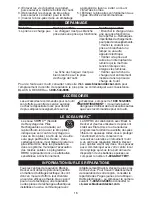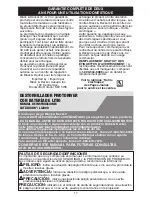
6
IMPORTANT: The batteries in your tool
are not fully charged at the factory. Before
attempting to charge them, thoroughly read
all of the safety instructions.
• The charging socket (5) is keyed to
lock out other chargers. Align the tab in
the charger plug (7) with the key in the
charging socket.
• Insert charger plug into the charging
socket of the tool as shown in figure B.
• Plug the charger into any standard 120
Volt 60 Hz electrical outlet.
• Let the tool charge initially for at least 16 hours.
After the initial charge, your tool should be fully
charged in 12 hours from a fully discharged
condition. Recharge discharged batteries
as soon as possible after use or battery
life may be greatly diminished. for longest
battery life, do not discharge batteries
fully. It is recommended that the batteries be
recharged after each use.
WARNINg:
Do not use tool while it is
connected to the charger.
WARNINg:
fire hazard. When
disconnecting the charger from the tool, be
sure to unplug the charger from the outlet
first, then disconnect the charger cord
from the tool.
Important Charging Notes
1. Your tool was sent from the factory
in an uncharged condition. Before
attempting to use it, it must be charged
for at least 16 hours.
2.
CAUTION:
To reduce the risk of
damage to the batteries, NEVER charge
them in an air temperature below 40°F
(4,5°C) or above 105°F (40,5°C). Also,
NEVER charge them if the battery
temperature is below 40°F (4,5°C) or
above 105°F (40,5°C). Longest life and
best performance occurs when batteries
are charged with an air temperature of
approximately 75°F (24°C).
3. While charging, the charger may hum and
become warm to touch. This is a normal
condition and does not indicate a problem.
4. If the batteries do not charge properly—
(1) Check current at receptacle by
plugging in a lamp or other appliance.
(2) Check to see if receptacle is
connected to a light switch which turns
power off when you turn out the lights.
(3) Check that the charger plug is fully
inserted into the charger port on the
tool. (4) If the receptacle is Ok, and
you do not get proper charging, take or
send the tool and charger to your local
Black & Decker service center. See
Tools Electric in yellow pages.
5. The tool should be recharged when
it fails to produce sufficient power on
jobs which were easily done previously.
Battery life may be greatly diminished
if batteries are discharged deeply. DO
NOT CONTINUE using product with
its batteries in a depleted condition.
Recharge discharged batteries promptly.
6. To maximize battery life:
a. Do not fully discharge batteries.
b. Fully recharge batteries after each use.
c. Store tool in a location where
the surrounding air temperature is
approximately 40°F - 75°F (4.5°C - 24°C).
d. Disconnect charger from tool after
charge is complete.
WARNINg:
Fire Hazard. When disconnecting the
charger from the tool, be sure to unplug
the charger from the outlet first, then
disconnect the charger cord from the tool.
Safety Warnings and
Instructions: Drilling
WARNINg:
Tool may stall (if
overloaded or improperly used)
causing a twist. To reduce the risk of
injury always expect the stall. Grip the
tool firmly to control the twisting action and
prevent loss of control which could cause
personal injury. If a stall does occur,release
the trigger immediately and determine the
reason for the stall before re-starting.
ASSeMBLy AND ADjUSTMeNT
ChARgINg PROCeDURe
INSeRTINg AND ReMOvINg BITS
(fIgURe C)
• Before installing or removing bits, move
the forward/ reverse slider (1) to the center
“lock-off” position as shown in insert.
• To install a bit, insert it into the cavity in the
hex spindle as shown in figure C.
• To remove the bit pull it straight out.
• For bit tips, use a bit tip extender as shown.
NOTe: Only hex end bits will fit in spindle.
PIvOTINg The TOOL hANDLe (fIgUReS D, e)
• The handle of the tool can be pivoted into
three positions for optimum versatility as
shown in figure D.
• To pivot the tool handle, press the pivot
release button (2) as shown in figure e.
• Release the button in any one of the two
remaining locked positions.
WARNINg:
Check to make sure tool
handle is locked after pressing pivot release
button and changing screwdriver positions.
WARNINg:
• To avoid being pinched at the areas
indicated with black arrows, hold the
screwdriver at both ends and use your
thumb to depress the pivot release button
when changing positions.
Summary of Contents for LI2000
Page 26: ...26 ...


